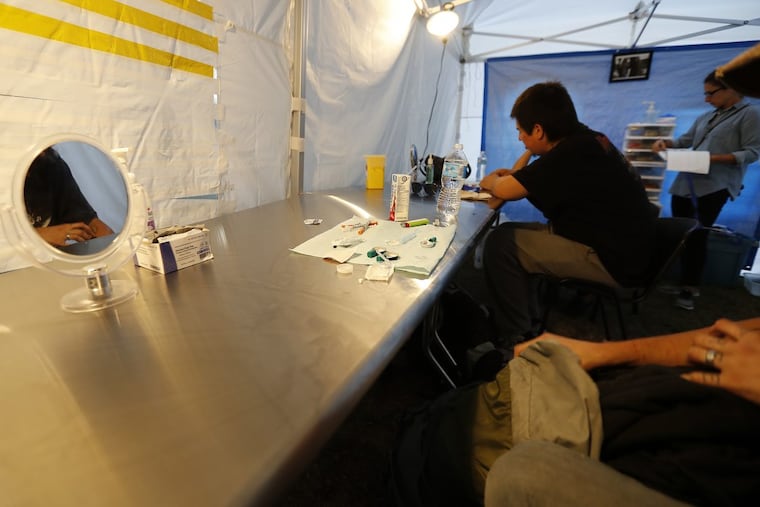Projecting 1,250 overdose deaths for the year, Philly considers safe-injection sites | Mike Newall
"It's the most comprehensive harm-reduction model I've ever seen," said David Jones, commissioner of the city department of behavioral health.

When a young woman overdosed in front of me under the Lehigh Street bridge last month, I did what the outreach workers in the neighborhood had taught me to do: I gave her Narcan from one of the packs that they've been blanketing Kensington with for months.
The first dose wasn't enough. But then I turned around, and there was a small line forming behind me — young people on the avenue, in addiction themselves, with their own Narcan packs at the ready. After a second dose from a young man's pack, the woman gasped to life.
I might have written this off as sheer luck. But this scene plays out in front of me more and more in Kensington these days. Overdose victims who would have garnered barely a glance a month ago are now being revived not just by police and paramedics, not just by outreach workers, but by others in addiction, equipped with the tools to save them.
That's because, since July, the city has handed out 19,000 packs of Narcan across Philadelphia — more than triple what it handed out all last year. They call it "flooding the zone." And it's saving lives in Kensington, even as the city projects 1,250 overdose deaths this year, the overwhelming majority from opioids. That's one more death per day than last year's toll.
We can't Narcan our way out of this crisis. But the first step in solving it is simply keeping people alive. And while the death rate grows to unimaginable heights, I find myself thinking back to what the McPherson Square library lawn looked like in May.
There, a single librarian and a pack of Narcan were all that stood between life and death for crowds of heroin users on the grass. Think of the deaths this city would have weathered without that flood of Narcan.
The Narcan troops show where the city is now, and how far it's come since last year, back when every city agency dealing with the crisis was left to its own devices. Individual heroics filled the void left by the absence of a comprehensive plan. Now, those city agencies are working together — and that plan, borne out of the city's heroin task force, is in play.
The city agencies are speaking a common language now — and this in a city where the Health Department was not actively involved in fighting the crisis until last year.
You can see momentum in the tactics coming out of the task force: a drive to persuade doctors to prescribe fewer opioids, an emphasis on getting people into medically assisted treatment, and harm-reduction techniques that help save people who are not yet ready for treatment. There's a plan to station recovery workers in emergency rooms to meet victims of nonfatal overdoses and get them into treatment — known as "warm handoffs."
In city prisons, there's an effort to improve treatment for some 6,000 inmates suffering from opioid use disorder — and to give them Narcan packs on their way out the door.
So where are we with safe-injection sites? In Kensington, prevention, education, and treatment won't be enough if you can't keep people alive.
The city seems to be coming around. At a task force meeting last week, the city health commissioner, Dr. Thomas Farley, and other officials reported on their trip to a site in Vancouver — and they sounded like people who had seen the light.
"It's the most comprehensive harm-reduction model I've ever seen," said David Jones, commissioner of Philadelphia's department of behavioral health. Farley spoke about how normal the site in Vancouver seemed — how it saved lives, undeniably. Even though heroin overdose deaths are spiking in Vancouver, in the 10 years the safe-injection site has been open, not a single person has died on the premises.
"These show a model for how supervised injections could occur and save lives," Farley said. "And it was a model supported widely not just by medical staff and community advocates but also by the police department." The sites weren't a panacea, they stressed — but in Canada, and soon in Seattle, they were a vital part of the solution.
Philadelphia is expected to make a decision soon. It needs to be the right one.
There are signs of hope in this crisis: Deaths in the last quarter dropped slightly.
But Farley is reluctant to put too much stock in those numbers. The city's efforts could be working, the Narcan handouts could be saving people, but the heroin supply may just not be spiked with as much fentanyl as before. A single deadly batch could send the death rate soaring.
And people are still dying alone in Kensington, quietly, in doorways and alleyways and bedrooms.
Thursday, it was a young man in an alley off Somerset Street. I passed by as the paramedics pulled up. He was dead when they found him. And he was alone. There was no line of people waiting with Narcan. The medics covered his body and loaded it into the ambulance. They closed the doors and drove off.